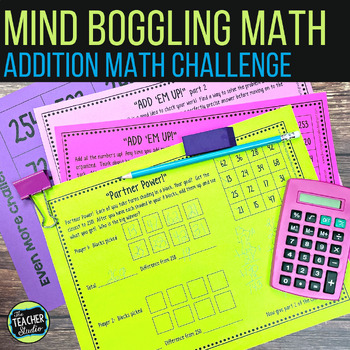Addition With Regrouping Enrichment - Mind Boggling Math - print and digital
- PDF
- Google Apps™

What educators are saying
Description
This addition with regrouping math resource came to me as I continue to search for low prep, ready-to-print ways to challenge my math students and provide enrichment while still addressing all rigorous state standards. Now it even includes a digital component for optimum flexibility.
These 10 tasks incorporate higher-level thinking, estimation strategies, and have multiple solutions! I want students to be able to work independently or with peers so directions need to be simple and easy to follow.
In addition to providing a HUGE amount of practice with addition with regrouping and problem solving, this resource is designed to really help students develop their understanding of place value and number sense—critical foundations for more advanced math concepts.
Students are asked to do a number of different activities requiring estimating and addition with regrouping. There is a TON of flexibility with this resource, and I hope you can find a great way to make it work for you and your students! I designed it to be very low ink as well.
So—what are your options? For me, I love having the Mind Boggling Math displayed in my room so students can access it any time. If you don’t have the wall space or want to use it with only one child, don’t worry! I have included a single page version of the board and really everything you need is included on the student sheets! It can be a stand alone resource! So what do you get?
"**************************************************************************
- Letters to spell “Mind Boggling Math” for a bulletin board (optional)
- Full page number grid to use if you want students to have their own copy
- Five, two-part math challenges
- Digital access to these 10 main challenges
- The number tiles ready to cut out and use on a display
- 5 ADDITIONAL “Even More” challenges so you can use this activity over and over again!
"**************************************************************************
***What are teachers saying about this resource?***
"I am so excited to use this resource in my classroom! I really think it will challenge my students. Thank you!"
"These rocked my students' world! I loved the challenge in them!"
"Used this as an early finisher station. A lot of choices for students and easy to prep. It made a nice looking bulletin board, too!"
**************************************************************************"
Looking for other versions?
Mind Boggling Math Grade 2/3 Version
Mind Boggling Math Grade Money/Decimals Version
------------------------------------------------------------------------------------------------------
All rights reserved by ©The Teacher Studio. Purchase of this resource entitles the purchaser the right to reproduce the pages in limited quantities for single classroom use only. Duplication for an entire school, an entire school system, or commercial purposes is strictly forbidden without written permission from the author at fourthgradestudio@gmail.com. Additional licenses are available at a reduced price.





